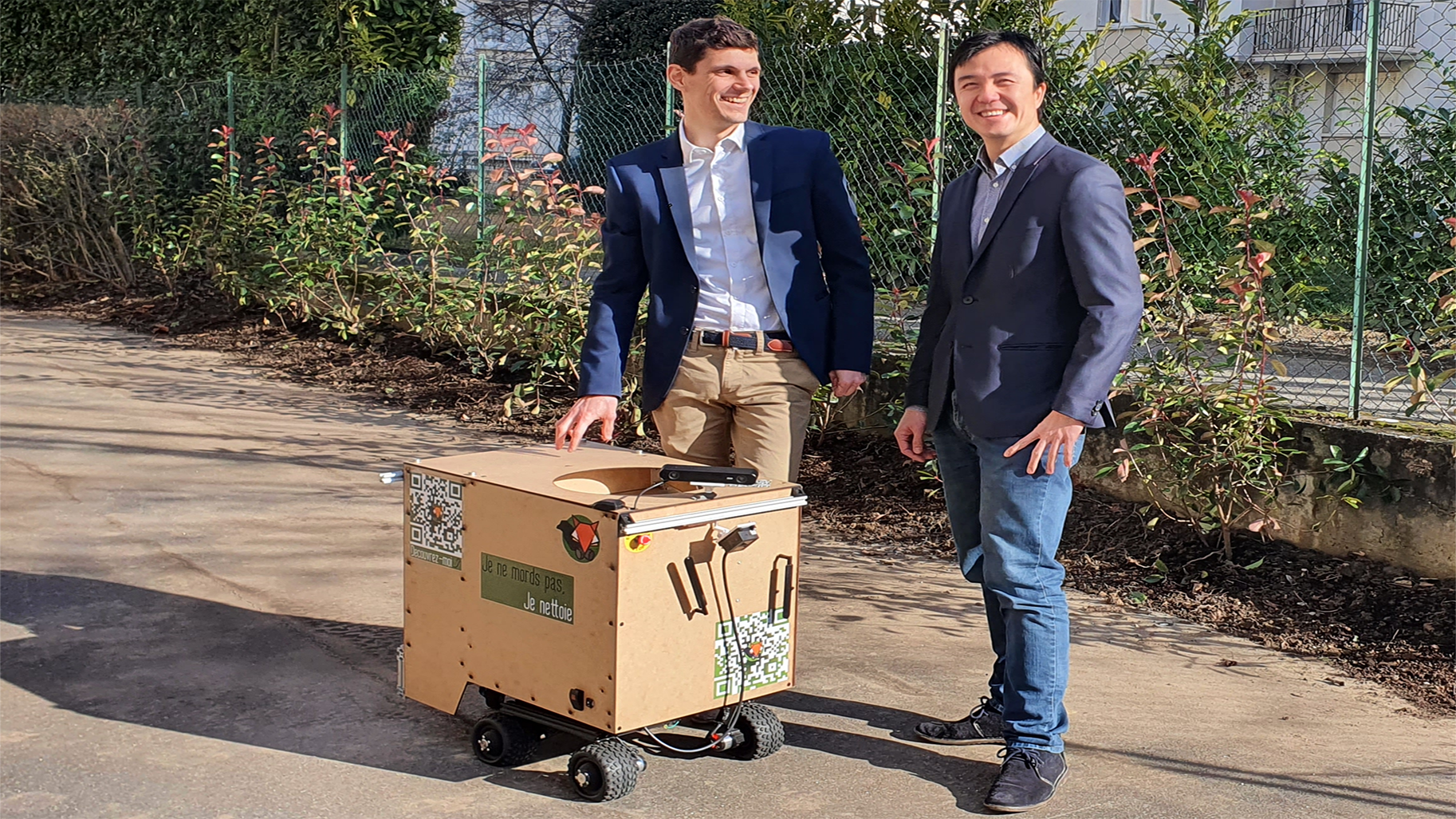Robotics: could Wall-E exist one day?
Date:
Changed on 19/04/2023

Have you seen the animated film Wall-E? The story is about an autonomous domestic robot left alone on Earth, which is overflowing with rubbish. To address the very real environmental challenges of waste management and assist the work of maintenance staff, this character could soon become a reality, under the name of CrowFox.
CrowFox was born out of the environmental awareness of Vincent Le Doze, a 30-year-old research engineer who studied at ENSTA Bretagne. In 2020, he worked in the CHROMA team at the Inria-INSA Lyon & Grenoble centre where he contributed to designing algorithms and developing models for the navigation and operation of mobile robots in dynamic environments in which they are required to interact with humans.
But then an ADEME report on littering got the young engineer thinking. He saw that “in spite of awareness campaigns, the problem of illegal dumping continues and is getting worse”. This concern also appealed to his entrepreneurial spirit and sparked a desire to use his skills to propose a way to help collect waste scattered in the environment. His idea was for a robotic solution based on artificial intelligence, of course!
His idea was promising and the context favourable. On the advice of his team leader Olivier Simonin, a University Professor at INSA Lyon, Vincent Le Doze approached the management at Inria who suggested he join Inria Startup Studio, the Institute's support scheme for digital deeptech entrepreneurs. The support from Inria financed his salary and that of Alexis Saget, an engineer who helped the project, for a year, as well as the purchase of the components needed to build the first demonstration models.
Vincent Le Doze initially envisaged a dual-robot system. The idea was to “pair up a drone (crow) that would detect rubbish on the ground with a land robot (fox) that would go and pick it up”. However, due to the technical and regulatory complexity of this project and the difficulties in terms of social acceptability of occupying public airspace, his idea had to be adjusted to focus on the land robot part.
He was able to base the design of the latter on a number of existing solutions. For example, the basic physical structure is inspired by LeoRover, a compact and watertight robot with off-road wheels, while the software uses deep learning networks with open-source code which can easily be retrained. Similarly, the design of a preliminary model capable of visually detecting and identifying rubbish in its environment was facilitated by TACO, an academic database of photos of rubbish.
Unlike its cousin the robot lawn mower, which is limited to a given area defined by an underground cable, CrowFox can locate itself autonomously. This feature was achieved by combining GPS with a proprioceptive technique called “visual odometry”, which consists in measuring the robot’s movements relative to a starting position using visual information from a stereoscopic camera with speed and acceleration measurements taken directly on the wheels. The robot is therefore able to “recognise” its environment and precisely adjust its position on a map. By combining these two technologies - GPS and odometry - the project compensates for their respective shortcomings and enables the robot to locate itself with an accuracy of around 10cm!
CrowFox's navigation strategy was initially designed as a pre-determined itinerary, a route with compulsory checkpoints. But “it will probably evolve into the specific patrol of areas most likely to contain rubbish, depending on the experience accumulated by the robot and the indications of human operators familiar with the site”. Although CrowFox can carry out its task autonomously, it can also be supervised remotely, for example to define areas to be cleaned or report on the progress of its rounds or any problems encountered (if the robot gets stuck, is vandalised, etc.). To achieve this, its designers drew on IoT technology and have equipped their machine with a 4G antenna.
For Vincent Le Doze, 2021 was dedicated to the development of prototypes and studying target markets. To refine the mechanical part, i.e. the collection of rubbish, he needed to more clearly identify CrowFox’s end users. The first potential users included leisure parks, tourist sites and motorways, but these all already had solutions in place. However, this was no reason to be discouraged as there were still other possibilities such as beaches, campuses, events, etc.
But exploring them is time consuming. Vincent Le Doze therefore went in search of a partner for the commercial development of the project. Thanks to Inria's support, he published an ad on the Les Deeptech.fr platform when it was launched in September 2021 by BpiFrance,
and subsequently met 40-year-old engineer Chin Lim. After completing a Master’s degree in engineering at Université Laval (Canada), Chin Lim worked for 14 years in the gas industry and flue gas treatment. He had also developed a concern for the environment. The father of a three-year-old girl, he wanted change over to a more meaningful profession that would also allow him to satisfy his business ambitions.
The two of them got on well. The project meets the two engineers’ desire to “show by example that robotics and artificial intelligence can be used to serve humans and the environment”. In mid-January 2022, they joined the SQYcub incubator via its partner Incub'alliance. Their new agenda includes business strategy courses, the creation of the economic model, reflection on the company model, the search for investors, etc. Their first target milestone, set for June, is to decide whether or not to create a start-up.
“A robot to assist cleaning teams that is scalable, modular, easy to update and is eco-designed and manufactured in France by a company with a mission whose governance is centred around the spirit of initiative of its employees”. This is the future that Vincent Le Doze and Chin Lim envisage. It is a pertinent way of showing that robotics and computer science can help respond to the major ecological challenges of our time.